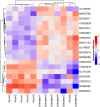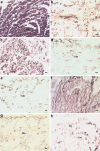The meristem-associated endosymbiont Methylorubrum extorquens DSM13060 reprograms development and stress responses of pine seedlings
- PMID: 34328183
- PMCID: PMC8842435
- DOI: 10.1093/treephys/tpab102
The meristem-associated endosymbiont Methylorubrum extorquens DSM13060 reprograms development and stress responses of pine seedlings
Abstract
Microbes living in plant tissues-endophytes-are mainly studied in crop plants where they typically colonize the root apoplast. Trees-a large carbon source with a high capacity for photosynthesis-provide a variety of niches for endophytic colonization. We have earlier identified a new type of plant-endophyte interaction in buds of adult Scots pine, where Methylorubrum species live inside the meristematic cells. The endosymbiont Methylorubrum extorquens DSM13060 significantly increases needle and root growth of pine seedlings without producing plant hormones, but by aggregating around host nuclei. Here, we studied gene expression and metabolites of the pine host induced by M. extorquens DSM13060 infection. Malic acid was produced by pine to potentially boost M. extorquens colonization and interaction. Based on gene expression, the endosymbiont activated the auxin- and ethylene (ET)-associated hormonal pathways through induction of CUL1 and HYL1, and suppressed salicylic and abscisic acid signaling of pine. Infection by the endosymbiont had an effect on pine meristem and leaf development through activation of GLP1-7 and ALE2, and suppressed flowering, root hair and lateral root formation by downregulation of AGL8, plantacyanin, GASA7, COW1 and RALFL34. Despite of systemic infection of pine seedlings by the endosymbiont, the pine genes CUL1, ETR2, ERF3, HYL, GLP1-7 and CYP71 were highly expressed in the shoot apical meristem, rarely in needles and not in stem or root tissues. Low expression of MERI5, CLH2, EULS3 and high quantities of ononitol suggest that endosymbiont promotes viability and protects pine seedlings against abiotic stress. Our results indicate that the endosymbiont positively affects host development and stress tolerance through mechanisms previously unknown for endophytic bacteria, manipulation of plant hormone signaling pathways, downregulation of senescence and cell death-associated genes and induction of ononitol biosynthesis.
Keywords: intracellular; metabolism; plant–microbe interactions; symbiosis; transcription network.
© The Author(s) 2021. Published by Oxford University Press.
Figures









References
-
- Ahn IP, Lee SW, Suh SC (2007) Rhizobacteria-induced priming in Arabidopsis is dependent on ethylene, jasmonic acid, and NPR1. Mol Plant Microbe Interact 20:759–768. - PubMed
-
- Alché JDD, M’rani-Alaoui M, Castro AJ, Rodríguez-García MI (2004) Ole e 1, the major allergen from olive (Olea europaea L.) pollen, increases its expression and is released to the culture medium during in vitro germination. Plant Cell Physiol 45:1149–1157. - PubMed
-
- Ardanov P, Ovcharenko L, Zaets I, Kozyrovska N, Pirttilä AM (2011) Endophytic bacteria enhancing growth and disease resistance of potato (Solanum tuberosum L.). Biol Control 56:43–49.
-
- Balasubramanian V, Vashisht D, Cletus J, Sakthivel N (2012) Plant β-1,3-glucanases: their biological functions and transgenic expression against phytopathogenic fungi. Biotechnol Lett 34:1983–1990. - PubMed
Publication types
MeSH terms
LinkOut - more resources
Full Text Sources
Molecular Biology Databases
Miscellaneous

